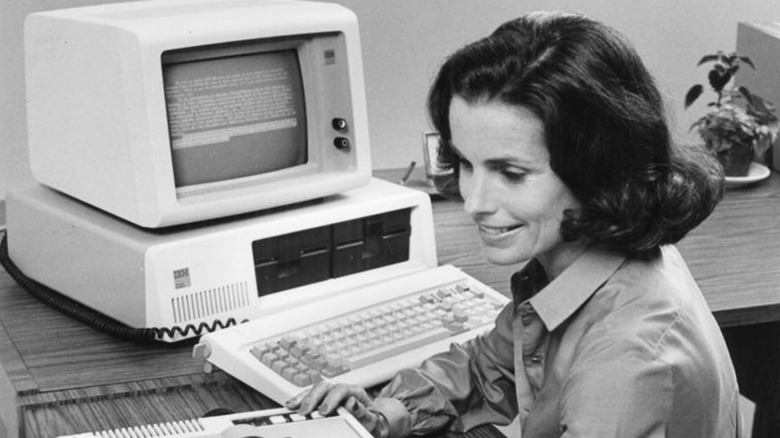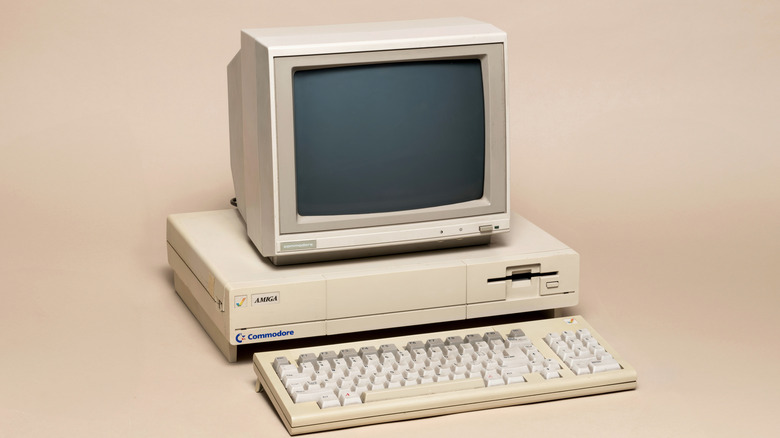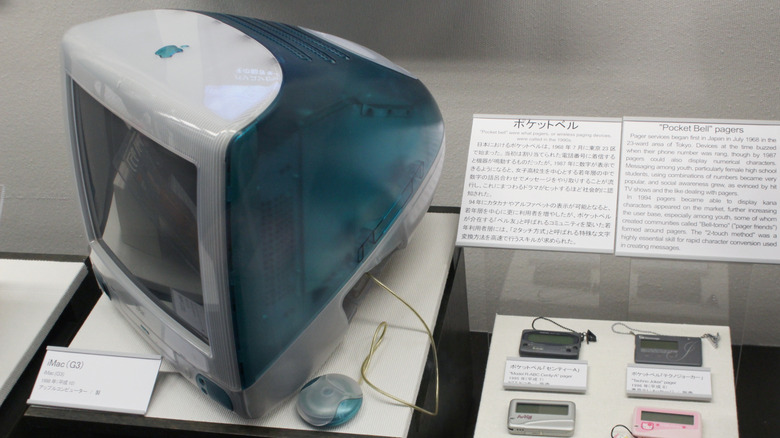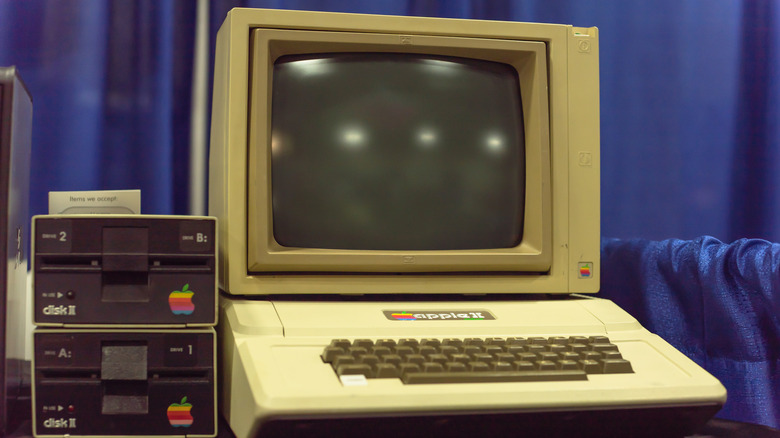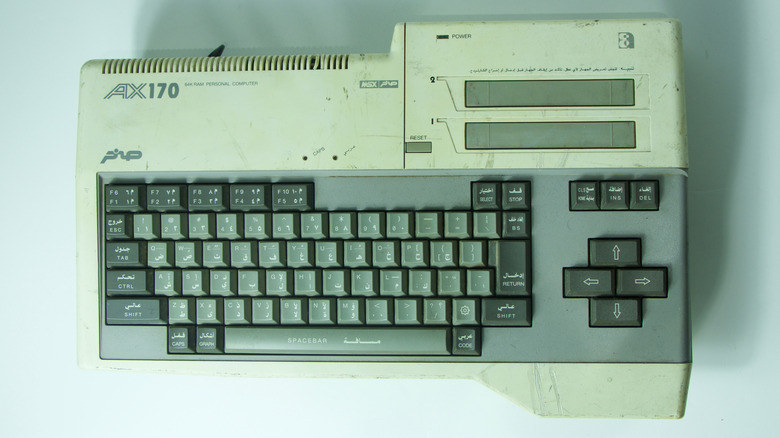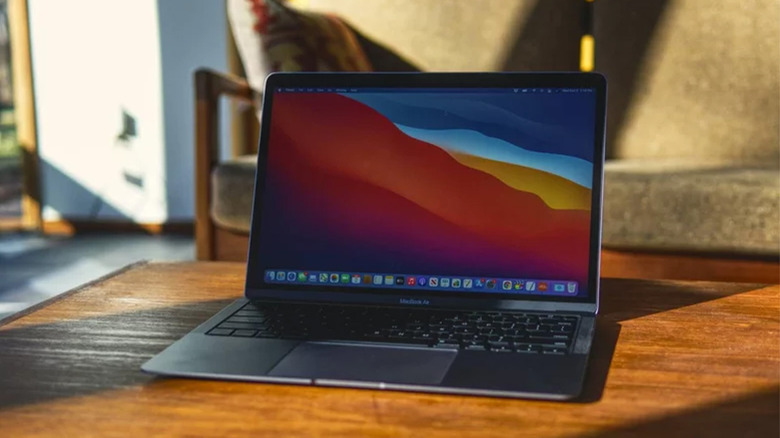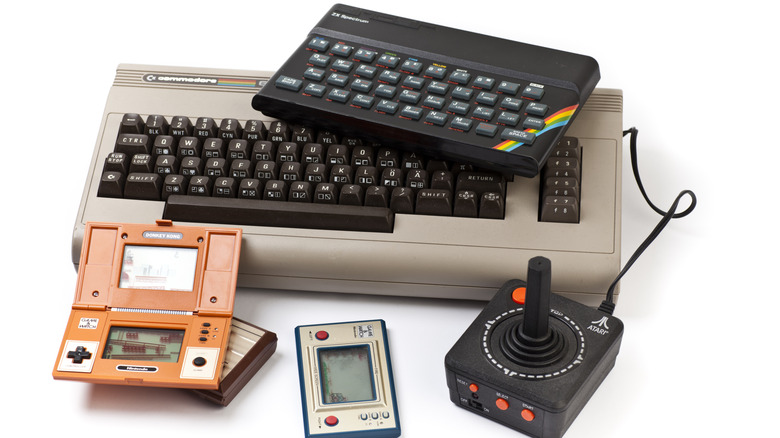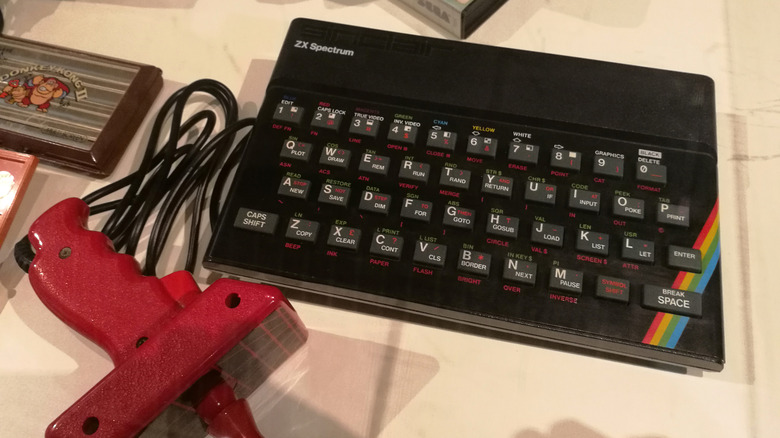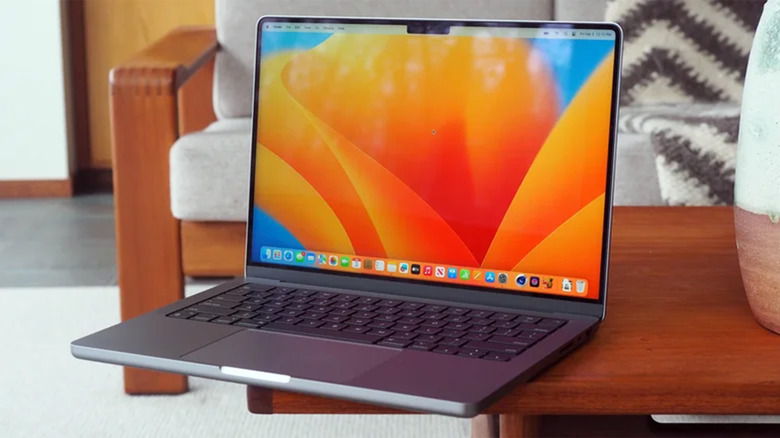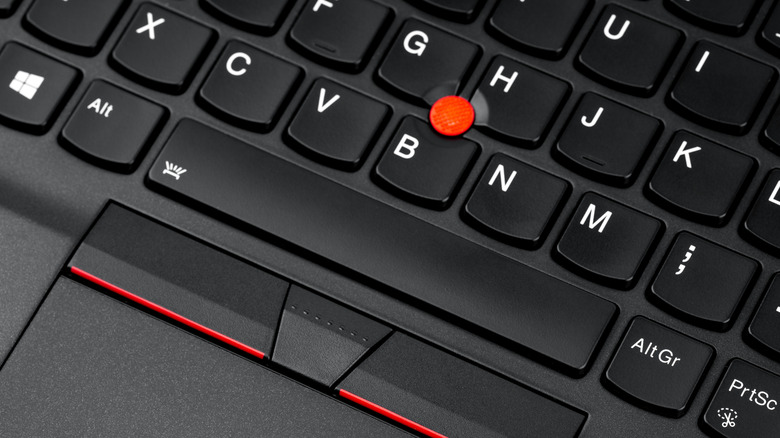10 Of The Best-Selling Computers Of All Time, Ranked
The personal computer has been around in some form for another since the release of John Blankenbaker's Kenbak-1 in 1971. However, it wasn't until 1975 that the PC hit the consumer market with the Altair 8800. As with most technology, the personal computer existed for a while before it hit the mainstream. While PCs became popular in the 1980s, it wasn't until the 1990s that they became a household item. I can attest to that, as my home got its first computer in the mid-1990s. It was a Gateway 2000 that came in its hallmark cow-spotted box.
Today, nearly 95% of households in the United States have at least one computer with many having multiple. Of course, smartphones are included in that total as they are functionally computers that can make phone calls. However, 81% of those households have either a desktop or laptop computer. Several huge releases helped kickstart the trend, such as the Commodore 64, Commodore Amiga, the IBM 5150, and others. Some of those systems sold millions of units and were mainstays in households before the modern PC landscape took hold.
Today, there is such a wealth of options to buy good, reliable computers that we don't see huge sales numbers for individual models much anymore. That means most of the highest selling personal computers of all time are moldy oldies, back when there was less competition. Even so, some modern computers make the list and may yet overtake the established champions in the space.
10. IBM 5150
The IBM 5150, made this PC from 1981 until 1987, was one of the most iconic PCs ever built, and it sold a ton of units. The exact total is difficult to find, but a 1987 infographic from InfoWorld Magazine puts the total at somewhere around 3.26 million units. It was such a big deal that Apple put out an advertisement congratulating IBM on joining the PC industry, which Apple called "the most exciting and important marketplace since the computer revolution began."
The specs were excellent for its time. It ran Intel's 8088 CPU, which was clocked at a blistering 5 MHz. Yes, that's an M there, not a G. Also included was Microsoft's MS-DOS, 64KB of memory, and a floppy drive to read and write storage. These specs would improve over time as IBM build more and more PCs. Still, the 5150 was a hit, at one point even garnering 80% of the PC market share in the early 1980s.
However, the 5150's true value to PC history was using parts from other companies. Intel built the CPU, Microsoft built the OS, and IBM essentially just put it all together. That's how most of today's PCs are built as it allows makers to be much more versatile and quicker with their offerings since other companies did much of the work, and it remains the de facto way to make PCs to this day.
9. Commodore Amiga
Commodore was one of IBM's biggest competitors in the 1980s and the company's big hit from back then was the Commodore Amiga. Commodore sales figures are criminally difficult to find, and many are considered to be inaccurate. However, YouTuber Ahoy took a deep dive into sales figures and other factoids from those days and came to the conclusion that the Commodore Amiga sold somewhere around 4.91 million units over its lifespan. Commodore sold the Amiga from 1985 until the company went bankrupt in 1994. Escom, the company that bought Commodore, tried to keep it going but eventually went bankrupt itself in 1997.
The Commodore Amiga was one of the first home PCs that supported both graphics and sound, as most personal computers were only capable of displaying text back in those days. Its impressive specs for its time and its ability to render graphics made it one of the first creative-focused PCs for things like moviemaking and one of the first gaming PCs. It also supported a wide range of third-party add-ons, giving it even more functionality.
Despite being hugely versatile, it couldn't keep up with the competition from IBM and Apple, eventually causing the company to fail. There have been attempts to revive the Commodore and Amiga branding over the years, including an Amiga mini-PC from 2012 and the Commodore phone that came with a Commodore 64 emulator pre-installed. However, neither of these reimagining were meant to be, and the Amiga brand has since been dormant.
8. iMac G3
Apple will make several appearances on this list, starting first with the iMac G3. Exact sales numbers are difficult to track down, especially since Apple has reused the name for several different products since. However, in this instance, we're talking about the iconic iMacs that sported the colorful plastic backs. This model was technically known as the iMac G3 but was marketed as the iMac from 1998 until 2003, when Apple retired the design. Exact sales figures are difficult to find but Steve Jobs claimed that Apple had sold over six million by the end of 2002.
I grew up in the late 1990s and early 2000s and I can tell you from experience that these things were everywhere — from the movie "Zoolander" where Owen Wilson chucks one of these things from a few stories up to a background role on Tina Fey's desk in "Mean Girls." The loud colors made them instantly recognizable and Apple did a good job of making them useful enough to warrant buying one.
Apple would eventually retire the G3 iMac in 2003 before moving to the G4 design. Apple still sells the iMac with the newest version coming at the tail end of 2024. Technically, if you added up all the sales figures for each successive generation, then it's possible the iMac may have topped the list since it has been so popular for so long. However, each generation is so uniquely different that the G3 deserves to stand on its own here.
7. Apple II
Apple came out of the gate swinging with the Apple II. It was the first commercially available product from the brand after the fledgling Apple I, and it sold like hotcakes. The Apple II also gets credit for being the first widely distributed computer with a microprocessor. Apple sold the Apple II in various configurations from 1977 until it finally ceased production in 1993. Apple didn't publicly disclose sales figures back then, but most estimates put the Apple II at somewhere between six and 6.5 million total units sold. However, those numbers do take into account every variant, including the Apple IIe, IIc, IIc Plus, and Apple IIGS models.
Since Apple sold the computer for a little over 15 years, the specs changed significantly over that time. It was such a cultural icon that Steve Jobs' entire reasoning for developing the Macintosh was to kill the Apple II. This led to the exceptionally effective and 1984 Super Bowl commercial from Apple unveiling the Macintosh computer. Apple has sold millions of Macs in the years since, but the Apple II kept the company afloat while it found its identity for the future.
It's honestly fairly impressive that the Apple II is on the list at all. Apple would go on to sell well over 100 million Macs in the following decades across dozens of products, but the Apple II remains as one of the single most successful products in the company's history. Plus, it can play "Portal." What else do you need?
6. MSX
MSX was a joint effort between multiple companies. It was started by Microsoft by the way of the creator of the ASCII Corporation, Kazuhiko Nishi, who was participating in Microsoft's attempt to bring computers to Asia in the late 1970s. The MSX came about from those efforts. It saw help from some big name companies, including Sony, Toshiba, and Panasonic. All of those companies would eventually make their own MSX PCs. In total, a total of nine million MSX PCs were sold worldwide.
The majority of those sales were in Japan with around five million sold. Other big buyers of the MSX computer were the U.S.S.R. with over a million, Spain with over 160,000, the Netherlands with over 400,000 sold, and the United Arab Emirates, where 1.3 million were sold. The rest were fairly evenly distributed over Europe and Asia. The U.S. was caught up in the Commodore 64 at the time, so MSX didn't sell well in North America.
MSX would eventually die out in the early 1990s as IBM's platform took over. However, MSX would leave its print on history. It joined the Commodore Amiga as one of the first PCs to support graphics and sound, making it great for gaming. One notable developer was Enix, who developed the game "Dragon Warrior" for MSX. Gamers may know this title better by its real name, "Dragon Quest." Enix would eventually merge with Squaresoft to create gaming giant Square Enix, which still develops games in the Dragon Quest series today.
5. MacBook Air M1 and M2
The MacBook Air M1 is an interesting case as it's not commonly listed on lists like this. However, we did some diving and found that Apple sells a ton of these things. From 2020 to 2024, Apple sold roughly 58.7 million Macs, according to Statista. Approximately 39% of those are MacBook Air laptops, as Apple sold the M1 version of the MacBook Air from 2020 through the first half of 2024. It also sold the MacBook Air M2 starting in 2022 and is continuing to sell it today.
Using that math, that means Apple has sold just under 23 million M1 and M2 MacBook Air laptops over the last four years, making Apple silicon versions of the MacBook Air some of the most successful computers in history. The exact breakdown is difficult to ascertain given the vague sales data, but we'd be willing to bet the M1 MacBook Air has more since it was sold for four years instead of just two like the M2 MacBook Air.
The Apple silicon-powered MacBooks were a huge departure from earlier MacBooks that were previously powered by Intel. It allowed Apple to better integrate its software and hardware, resulting in some serious computational gains. Mac fans seemed to have responded in kind by snatching these things up. Based on sales data, the M1 and M2 MacBook Air sold vastly better than its Intel-based counterparts, earning them a spot on the list.
4. Commodore 64
The Commodore 64 made its grand appearance in 1982 and became the go-to computer for millions of people in just a few short years. It helped make the home PC affordable while also being very functional. While other computers were going for over $1,000 in 1980 dollars — well north of $3,000 in today's money — the Commodore 64 was selling for as little as $230 during the mid-1980s. By the time it was discontinued in 1994, Commodore had sold significantly more than 10 million units.
Exact sales numbers are a little bit sticky. Commodore founder Jack Tramiel estimated that the console sold between 22 and 30 million units while other Commodore employees and sales reports put it somewhere around 17 million. However, software engineer Michael Steil put together sales reports, estimates, and figures from varying sources and puts the number at around 12.5 million total units sold. This is the number used by the Guinness Book of World Records.
Like most computers, there were multiple variants across the system's run, including a low-cost German variant sold at Aldi grocery stores. Most of its upgrades came in the form of expansion cartridges that slotted into the C64's expansion slot. Such add-ons included an MP3 player, CPU and GPU upgrades, and even RAM expansion. It currently holds the world record for the best selling desktop computer, although the ZX Spectrum may have its number if its sales figures can be proven someday.
3. ZX Spectrum
The ZX Spectrum is one of the most influential computers to ever exist. It was a solid all-around desktop, making it a reasonable purchase for work, homework, and home office use. However, the ZX Spectrum earned its bones by being one of the most popular and capable gaming PCs on the market. Thanks to its exceptional functionality and gaming prowess, the ZX Spectrum sold an estimated 13.6 million units during its production run from 1982 to 1992. By then, IBM PCs and home consoles began dominating the market.
It achieved this number by being sold under a variety of names. The original, made by Sinclair, sold about five million units overall. One million were made by Amstrad and millions more were produced in other countries like Spain and the U.S.S.R. It was also sold under the names Timex Color Computer and Didatik Gama along with other monikers. For the most part, enthusiasts also include clones in the sales totals because the games and software were still compatible. So while exact sales numbers are hard to pin down, they were likely nearly equal to the Commodore 64.
What powered ZX Spectrum's popularity wasn't just the technology but also the software. There are reports of nearly 23,000 games being produced for the ZX Spectrum, making it the first true gamer Gamers lovingly refer to the system as Speccy, and it was the start of a lot of gaming hobbies in the 1980s.
2. MacBook Pro M1
Earlier we talked about Apple sold 58.7 Macs between 2020 and 2024, and we pointed out that 39% of those were the MacBook Air laptops. The MacBook Pro did slightly better, with 51% of those sales. That means that Apple sold right around 30 million MacBook Pros featuring Apple silicon, which is about 10 million per year on average. The math gets more complicated as the M1 MacBook Pro was sold in various forms until early 2023 while the other two MacBook Pro generations lasted about a year each. Given that, we don't think it's absurd to say that the MacBook Pro M1 likely sold north of 15 million units all told but that is a rough estimate.
When the M1 MacBook Pro came out, we called it the best computer that Apple had built in a decade. The marriage of Apple's silicon with its software development was truly a sight to behold, with extremely good performance scores for productivity tasks and excellent battery life for how powerful it was. People loved the M1 MacBook Pro so much that they are still recommending it to people years after its release. Future MacBook Pro generations were equally excellent, but only lasted until the next MacBook Pro generation was released.
Apple officially discontinued the MacBook M1, but you can still occasionally find it in Apple's refurbished store. The M2 version was discontinued right at the end of 2023, and the M3 chip was retired in late 2024. Today, the M4 MacBook Pro is being sold.
1. IMB/Lenovo ThinkPad
The ThinkPad is one of the longest running tech products in history, with a lifetime of sales spanning over 30 years. As such, it's no surprise that they have sold a metric ton of units over the years. IBM started the brand in 1992, which included its now iconic red nub for controlling the mouse. IBM continued to make the laptop until it sold its PC division to Lenovo for $1.75 billion in 2005. Lenovo picked up where IBM left off and continues to make ThinkPads today. They look a lot different than their boxy predecessors, but they all still have the red nub, making them instantly recognizable in a photograph.
According to IBM directly, the ThinkPad has sold over 150 million units over its decades-long run so far. The only reason why the ThinkPad doesn't have a Guinness World Record is because the record is for desktop computers and not laptops. There have been dozens of models over the years with the usual array of upgrades you would expect in a laptop. Smaller chassis, stronger components, better screens, and more sleek designs. Even so, they continue to be built for home office and business use and are still popular with that crowd to this day.
Even if you took Lenovo's contributions out of the equation, IBM still sold over 20 million of these before it was sold to Lenovo in 2005. Even then, IBM's ThinkPads would still top the list. That's how popular it was.
Methodology
For the most part, the world was mostly done by enthusiasts before we showed up to scrape the data. We found dozens of sources across the Internet and made sure that those sources were cross-checked with established facts. For example, the Commodore 64's world record is for the 12.5 million units that it was calculated to have sold, not the 22 to 30 million that Commodore head honcho's claimed. It was easily the most difficult part of the article to verify sales claims, especially given that many companies don't post sales data very often.
The only contention on the list above is Apple. It shows units shipped rather than units sold, and it doesn't differentiate between its various models. Our data from that came from CIRP, which estimates that 51% of Apple Mac sales are MacBook Pros, 39% are MacBook Airs, and about 10% are the various iMac desktop computers. The rest was simple math. We want to reiterate and emphasize that those are estimated sales figures based on Statista and SIRP data, and not hard facts directly from Apple.
Such is also the case with ZX Spectrum and MSX computers, as those had many clones and various models made by different companies. Since the clones worked like the originals and could run the same software and games, many times they were included in the overall totals. For example, several sources claim MSX computers sold around nine million units, while ASCII founder Kazuhiko Nishi says it's closer to probably four million. Thus, all figures above are mostly speculative, but we are reasonably certain that they are in the ballpark of being accurate.

